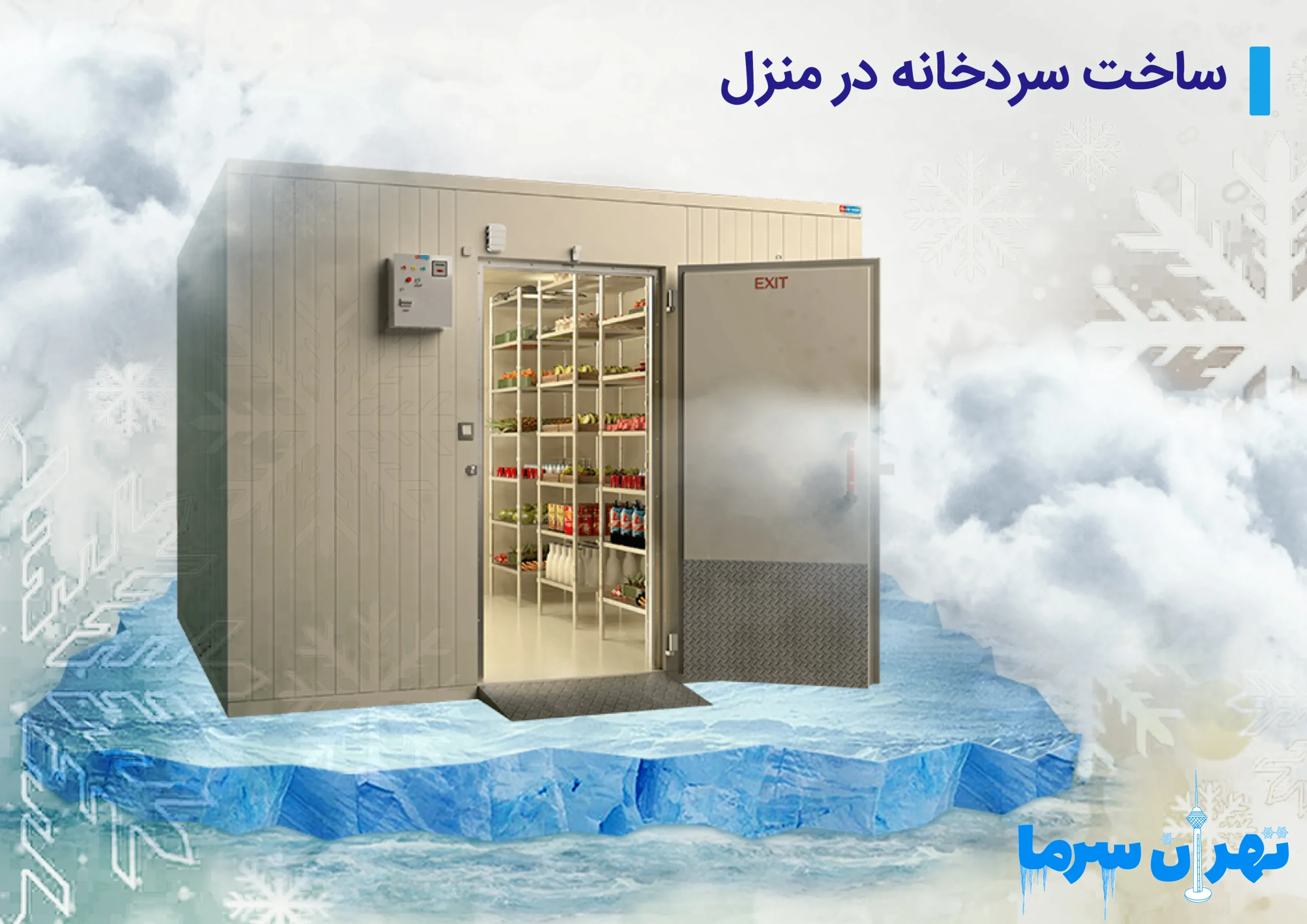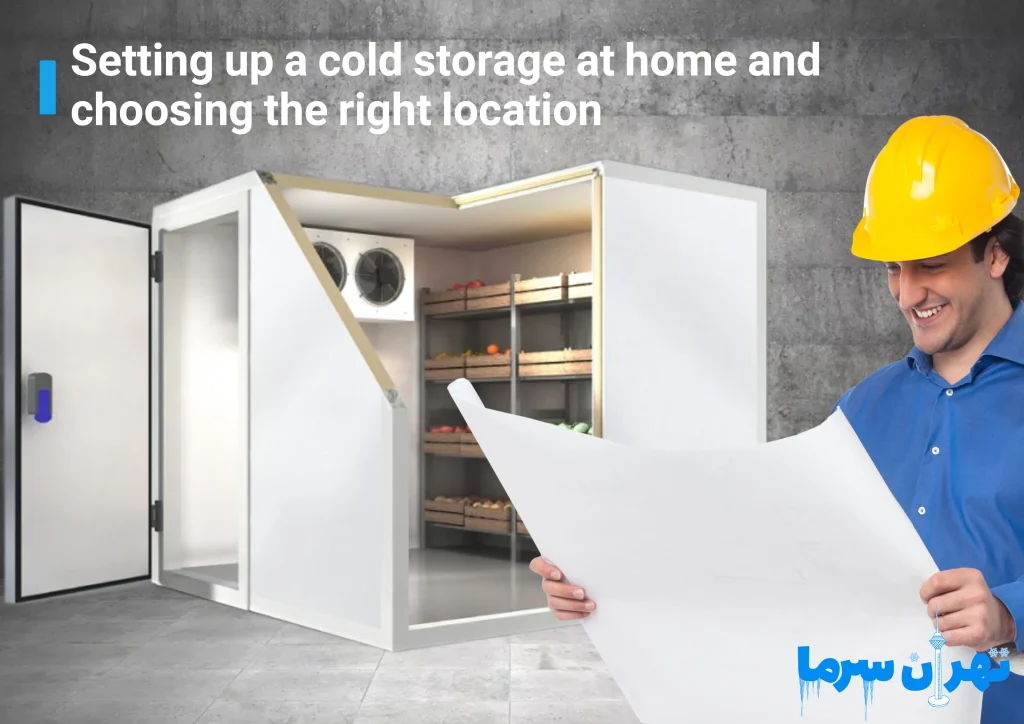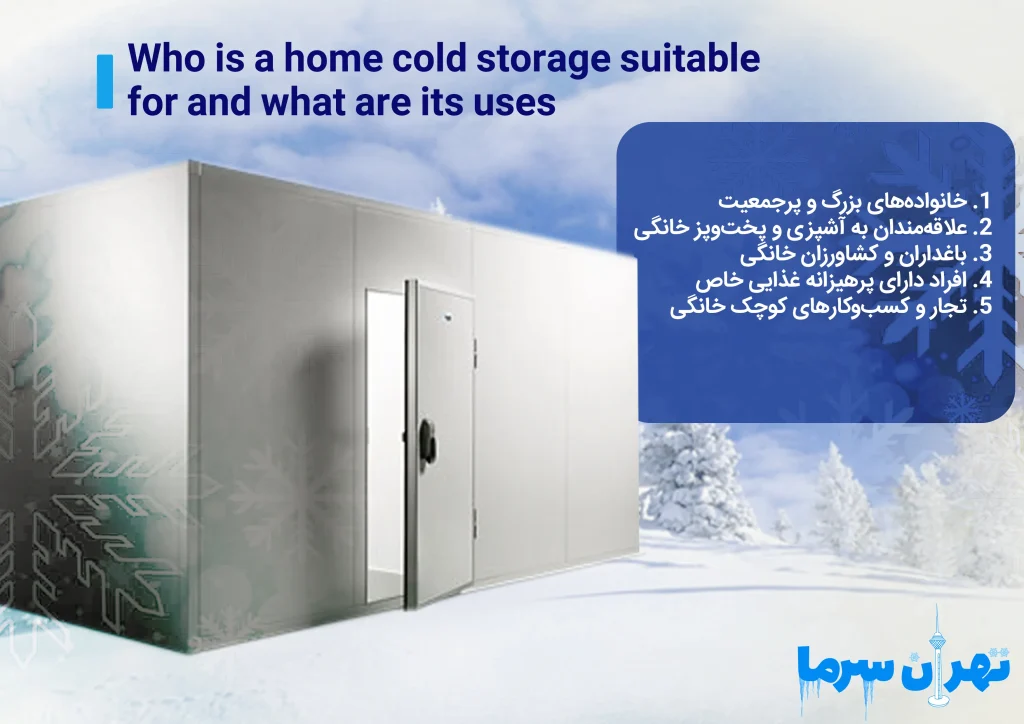Building a cold storage at home

To build a cold room at home, you should first carry out a site visit and choose a suitable location for its construction. Don’t forget that installing a home cold room requires specialists who can professionally set up these systems so that you can fully benefit from a cold room in your house. Next, review the cost of building a home cold room, which includes purchasing and installing refrigeration units, proper insulation, and temperature control systems.
Constructing a cold room in your residence can be done to store food for longer periods without spoilage. This project requires careful planning, appropriate equipment, and adherence to safety standards. Below, we explain in detail the steps and key considerations for building a home cold room:
Setting Up a Cold Room at Home and Choosing the Right Location
Choosing the right location is one of the first and most important steps in building a cold room. The selected space should meet the following conditions:
Easy access:
The cold room should be easily accessible, for example, near the kitchen or in the basement.
Proper insulation:
The walls and ceiling of the chosen location must allow for thermal insulation.
Adequate ventilation:
Make sure the space has proper ventilation to prevent moisture buildup.
Building and Designing a Cold Room at Home
The process of building a cold room at home involves several steps:
Dimensions and size:
The cold room’s dimensions should match your needs and the available space. For most homes, a cold room measuring around 2×2 meters is sufficient.
Type of door:
The door should be properly insulated. Foam doors or metal doors with thermal insulation are commonly used.
Shelving:
To better organize food items, use metal or plastic shelves that are resistant to moisture.
Thermal Insulation
Thermal insulation plays a critical role. You can use the following materials for insulating the walls and ceiling:
- Polyurethane: Highly effective as both thermal and moisture insulation.
- Polystyrene foam (EPS): Lightweight and efficient, commonly used for insulation.
- Pre-made insulation boards: Easily available in the market and simple to install.
Cooling System
Choosing the right cooling system is essential for building a cold room at home. Options include:
- Small industrial refrigerators: Easily available and capable of maintaining the desired temperature.
- Home chillers: Effective devices that can keep the cold room temperature stable.
- Air conditioning units: Some models can be set to lower temperatures and used as a cooling system for the cold room.
Temperature and Humidity Control
For precise control of temperature and humidity inside the cold room, use the following equipment:
- Thermostat: Automatically regulates the internal temperature.
- Hygrometer: Measures and controls humidity levels.
- Ventilation system: Prevents moisture buildup and provides fresh air circulation.
Installation and Setup
After purchasing the necessary equipment, proceed with installation:
- Install insulation: Apply thermal insulation to the walls and ceiling, ensuring there are no gaps.
- Install the cooling system: Follow the manufacturer’s instructions for installation.
- Install the door: Ensure the door is properly sealed and insulated.
- Install control equipment: Set up the thermostat, hygrometer, and ventilation system with proper adjustments.
Testing and Operation
Once installation is complete, test the cold room:
- Temperature and humidity: Monitor conditions for several days to ensure proper functionality.
- Continuous operation: Confirm the cooling and ventilation systems run consistently without interruption.
- Maintenance: Plan regular inspections and servicing to maintain peak performance.
Safety Considerations
Following safety guidelines during construction and operation is essential:
- Check for leaks: Ensure there are no refrigerant leaks in the system.
- Proper ventilation: Prevent the buildup of harmful gases.
- Easy access: The cold room must be accessible, with a door that opens and closes smoothly.
Optimization Strategies
To improve efficiency and performance, consider:
- Renewable energy sources: Use solar energy systems to power the cold room.
- Smart systems: Install smart controls for more precise temperature and humidity regulation.
- Energy recovery systems: Reduce electricity consumption by recycling energy.
Costs and Budgeting
Before starting, estimate costs and set a proper budget. Expenses may include equipment purchase, insulation materials, installation, setup, and ongoing maintenance.
What Are the Applications of a Home Cold Room
Building a cold room at home offers multiple benefits, helping you preserve food and temperature-sensitive products effectively:
- Food storage: Keep food fresh for longer and prevent spoilage, especially seasonal products that are not available year-round.
- Bulk storage: Buy in bulk and store food, saving money and reducing frequent shopping trips.
- Preserving garden or farm produce: Store freshly harvested fruits and vegetables to maintain their freshness and quality.
- Meat and seafood preservation:
- Store meat and fish at the right temperature to prevent spoilage and odor.
- Keep homemade meat products such as sausages, smoked fish, or cured meats hygienically.
- Dairy and eggs:
- Store milk, cheese, yogurt, and butter in the right conditions to prevent spoilage.
- Evaluate the costs of installing such a system before proceeding.
- Medicinal and pharmaceutical products:
- Safely store medicines that require low temperatures.
- Preserve vaccines and serums to maintain their effectiveness.
- Special and rare products:
- Safely store luxury foods such as caviar, specialty cheeses, or tropical fruits.
- Preserve medicinal herbs and plants while retaining their therapeutic properties.
Conclusion
A home cold room provides diverse benefits, from storing food and preserving medicines to keeping specialty products fresh. By using a home cold room, you can extend the shelf life of products, reduce costs, and maintain a healthier and more sustainable lifestyle. Although setting up a cold room at home requires planning and precision, the results can be highly valuable and rewarding.
Here’s the English translation of your text in a fluent and professional style:
Who Is a Home Cold Room Suitable For and What Are Its Uses
Building a cold room at home can be highly beneficial for different groups of people. Below are some of the groups that can take advantage of having a home cold room:
Large families
Families with many members and high food consumption need more space to store their groceries. A home cold room allows them to buy food in bulk and store it for longer periods. This helps reduce expenses and minimizes the frequency of shopping trips.
Cooking and home-cooking enthusiasts
People who enjoy cooking often require a wide variety of fresh ingredients. A home cold room enables them to keep ingredients fresh and high-quality, while also allowing them to store prepared meals for later use.
Gardeners and home farmers
Those who grow their own fruits and vegetables can benefit greatly from a home cold room. Freshly harvested produce can be stored in the cold room to maintain its quality and freshness, making it available throughout the year.
People with specific dietary needs
Individuals with medical dietary restrictions or personal preferences often need to store particular types of food. A home cold room allows them to safely preserve gluten-free items, organic products, low-fat foods, and other specialized diets at the right temperature.
Small home businesses
Home-based food businesses, such as bakers, confectioners, homemade meat product suppliers, or frozen food sellers, can use a cold room to store their products for longer periods while maintaining higher quality. This ensures better product reliability and customer satisfaction.
Professional Setup and Cost Considerations
Setting up a cold room at home requires consultation and assistance from a professional team. Tehran Sarma can be a suitable partner for this process. By visiting their website, you can contact the team, explore valuable resources similar to international references, and make more informed decisions.
Building a home cold room requires technical expertise to ensure you get an efficient and high-quality storage solution. The setup process generally includes selecting the right location, installing equipment, and making the final adjustments for optimal operation.
Before starting, it’s important to evaluate the cost of building a home cold room. These expenses include purchasing refrigeration units, insulation systems, and temperature control equipment, as well as installation and setup costs.




 سردخانه
سردخانه برق
برق کمپرسور
کمپرسور کمپرسور بیتزر
کمپرسور بیتزر کمپرسور کوپلند
کمپرسور کوپلند کمپرسور بوک
کمپرسور بوک کمپرسور دانفوس
کمپرسور دانفوس کمپرسور منیروپ دانفوس
کمپرسور منیروپ دانفوس کمپرسور امبراکو
کمپرسور امبراکو کمپرسور پاناسونیک
کمپرسور پاناسونیک کمپرسور سابکول
کمپرسور سابکول کمپرسور کوپلند
کمپرسور کوپلند کمپرسور اسکرال کوپلند
کمپرسور اسکرال کوپلند کمپرسورفراسکلد
کمپرسورفراسکلد کمپرسور رفکامپ
کمپرسور رفکامپ کمپرسور اسکرال دانفوس
کمپرسور اسکرال دانفوس گاز مبرد
گاز مبرد گاز R22
گاز R22 گاز R134
گاز R134 گاز R404
گاز R404 گاز R407
گاز R407 گاز R410
گاز R410 گاز R508
گاز R508 کندانسور هوایی
کندانسور هوایی اواپراتور
اواپراتور اواپراتور آرشه
اواپراتور آرشه اواپراتور صابکول
اواپراتور صابکول اواپراتور آسه
اواپراتور آسه اواپراتور نیک
اواپراتور نیک اواپراتور آرتک
اواپراتور آرتک اواپراتور نوین
اواپراتور نوین اواپراتور تبادل کار
اواپراتور تبادل کار درب
درب ساندویچ پنل
ساندویچ پنل فن سردخانه
فن سردخانه روغن کمپرسور سانیسو
روغن کمپرسور سانیسو متعلقات سردخانه
متعلقات سردخانه